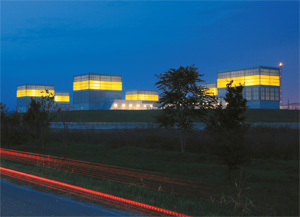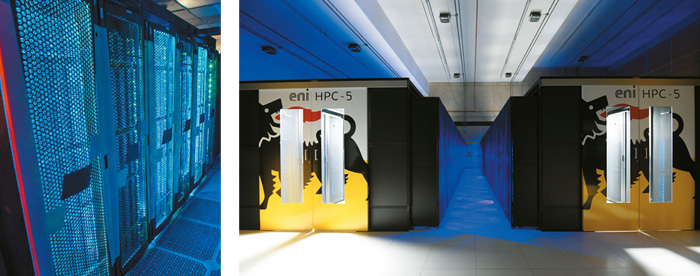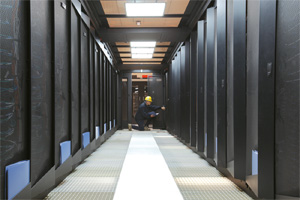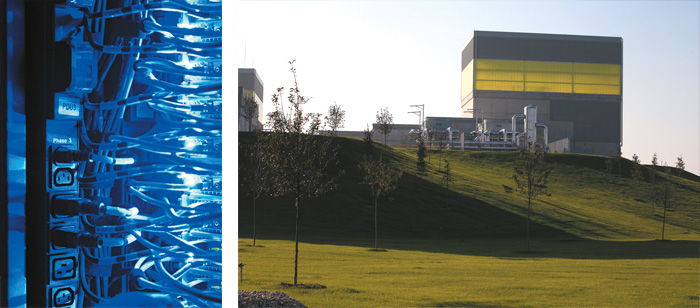Exclusive
Eni’s Digital Future
RESIST CHALLENGES TOGETHER
In 2020, the world faced a challenge that cannot be adequately met without combining the efforts of all countries, different social and business groups and all of humanity. This is a pandemic of the new, still unknown to the human mind, virus COVID-19. Guided by these considerations, Eni made available its high-performance supercomputer and molecular modeling skills to scientists who conduct research to counter the virus.
This work is carried out as part of the European project EXSCALATE4CoV, which is conducted by the Italian biopharmaceutical company Dompé, combining various institutions and research centers in Italy and other European countries. The studies test and identify the safest and most effective medications to counteract coronavirus.
Eni contributes to the project in partnership with Cineca, a non-profit research consortium that includes universities, national research centers, and the Italian Ministry of Education, Universities and Scientific Research.
Groups of specialists conduct dynamic molecular modeling of viral proteins belonging to the COVID-19 strain in order to identify the most effective pharmacological components among the 10,000 contained in the database. After that, a study will be made of new specific antiviral molecules through the selection and screening of billions of structures.
The hybrid architecture of the HPC5 computing system provided by Eni makes molecular modeling algorithms particularly efficient. «During a global emergency such as this, we must mobilize all available resources to overcome the challenges ahead. We are proud to contribute to finding solutions to this challenge facing humanity,» said Claudio Descalzi, Eni’s CEO.
«We are grateful to Eni for the invaluable contribution, and we are confident that this collaboration will contribute to the achievement of the goal in the foreseeable future, as well as provide a recovery model,» said Sanzio Bassini, Director of Cineca's supercomputing department.

«Eni has freely made its supercomputing infrastructure HPC5 and its molecular modelling skills available for the Coronavirus research, offering its contribution through its tools and resources of excellence in the fight against this global emergency,» Luca Vignati, Eni Executive Vice President for Central Asian Region, commented on the company's collaboration with the scientific community. «This activity will enable an accurate simulation of the molecules’ dynamic behavior, leading to a better understanding of how the virus can interact with an active ingredient of a specific drug. The simulations are very complex and require tremendous computing power. Eni is making available its HPC5, the most powerful industrial supercomputer in the world today, to support the research of a vaccine against COVID-19. We believe that we can help speed up several years of research, enabling the scientists to come up with an effective vaccine very shortly.»
NEW WORLD, NEW SPEEDS, NEW OPPORTUNITIES
For a profound digital transformation and technological progress, it is essential to boost up people’s skills, including cultural innovation, which creates a new way of working. This is achievable not only through training and proper communication, but also through a close teamwork. «I strongly believe that any initiative can go viral if it starts from a simple idea and morphs into something bigger through the valuable contributions from team members,» said Luca Vignati. «At the end of the day, each crisis is an opportunity. If we face it with grace, we will reach a new level with outstanding results. Digital transformation will gain momentum, and unfortunately, those who do not keep up with the times, or, even worse, do not keep ahead of the game, will miss the boat.»
According to him, over the past few years, Eni has undergone significant transformation to become a simpler, faster and more resilient energy company that integrates sustainability in all areas of its business, defining and adopting a new mission based on the UN SDGs.
«Now we are all witnessing how the COVID-19 pandemic has changed our lives. It put us in a lockdown, forcing businesses to change and reshape, giving rise to a tremendous number of projects that use digital solutions. Self-isolation, its economic consequences and rapid changes in business put digitalization in the forefront. The digital change was already underway; the pandemic has accelerated the process and showed the world that we are literally trapped without it. Like it or not, it was a turning point for the way people work, learn and even socialize. This is why I mentioned earlier resilience, agility and the need to keep up with the speed of digitalization,» summarized Luca Vignati. «On the other hand, despite the forced isolation, the virus has actually proved the world that it is possible to fight the crisis together, fostering international cooperation and solidarity. We see how countries help each other, how governments support business, how companies reach out to their communities to provide solidarity, and this is another turning point, when a problem unites us all. This is the time to unite and move together towards public health and safety, getting economies back on track with an outlook for a sustainable development.»
ENI’S DIGITALIZATION
Digitalization is the lever of sustainable development that can accelerate economic growth and, at the same time, improve access to energy and increase the environmental friendliness of the activities. Digitalization is playing an increasingly important role in promoting economic development both in Italy and in all 67 countries where Eni operates.
Eni's digital transformation spans all sectors and employs people, technology and skills in a way that delivers extraordinary results. The company was able to transform the need to process large amounts of data obtained as a result of research and technological activities into a strong competitive advantage that supports the technological progress of the company through the development of the skills of its employees.

«Digitalization helps companies in the oil and gas industry to increase the efficiency of capital investments, to reduce the cost of energy production and operating costs, by leveraging human capital, skills and behaviors,» believes Luca Vignati. «I would say it is a must rather than a competitive advantage in our current realities. Besides that, the world is changing faster than ever before, it is undergoing a major transformation, we know what we have left behind, but are not sure we fully understand what a new normal means and what it may look like. Therefore, companies as a whole, and us as individuals, need to be up to speed, become more agile and resilient, simultaneously. It may seem a contradiction, but it is not. We have to develop flexibility, the ability to change in the process of transforming the company and ourselves, become more nimble. Mastering new skills, the development of social and emotional qualities will acquire a decisive role; the ability to quickly adapt will become a key tool for our success.»
Eni Digital Business Unit was created at the end of 2018 with the goal of defining a digital strategy and carrying out a comprehensive transformation of all aspects of the company. This division identifies digital initiatives and, at the same time, promotes open innovation channels in order to expand the contribution of both academic and entrepreneurial centers of excellence in Italy and abroad.
What Eni does to develop advanced analytic tools is truly an innovative approach. Thus, the digital transformation in the field of drilling (Drilling and completion), for example, is based on three factors: artificial intelligence to support production decision-making, virtual reality for modeling and advanced robotics for automation of operations. This transformation is already helping to achieve three main goals: improving the safety of the facility, performance improvement and improved well planning.
THE LAUNCH OF THE SUPERCOMPUTER
On February 6, 2020, Eni introduced its new HPC5 computer in the presence of Eni CEO Claudio Descalzi, President Emma Marcegaglia1, several company partners in the field of research innovation development, such as the Massachusetts Institute of Technology (MIT), Stanford University, and the Nationa Research Council and the Polytechnic University of Turin, as well as technology
partners, such as Dell Technologies, Intel, and Nvidia.
Claudio Descalzi, CEO of Eni, said during the ceremony: «Today Eni unveils a supercomputing system with key features which are unique in the industrial world. This system is able to boost and even further refine the highly complex processes that support Eni’s people in their activities and therefore accelerate our digital transformation. This is an important time in the path toward the energy transition. It’s another step forward to the global goal that we share with our research and technology partners: making tomorrow’s energy an even closer reality».
The HPC4 computer system previously operating at the company was at the time one of the most powerful supercomputers in the industrial world. What made it unique was artificial intelligence, thanks to which it was capable of processing 18.6 Petaflops/second, (a petaflop is the capacity to carry out one thousand million million operations per second), and it assisted the company in geological exploration. By combining it with an existing HPC3 computer, Eni's peak computing power has increased to 22.4 Petaflops/second.
Thanks to HPC4, in May 2018, Eni made a breakthrough in oil and gas reservoir numerical modeling: the computer completed 100,000 high-resolution reservoir simulation cycles, taking into account geological uncertainties, in a record 15 hours. For the sake of comparison, most oil and gas field engineers can complete just one simulation cycle in a few hours using a computer with standard software.
The new HPC5 supercomputer, located in the Green Data Center in Ferrera Erbognone, supports the previous system (HPC4), thus increasing the computing power by 3 times: from 18 to 52 Petaflops per second, which is equivalent to 52 million billion mathematical operations per second, allowing Eni's high-powered computing ecosystem to achieve a total peak power of 70 Petaflops per second. HPC5 is truly a unique, most powerful computing infrastructure in the industrial sector, which allows the company to reach the next important stage of its digitalization process.

The impressive increase in computing power obtained through the use of hybrid architecture helps Eni achieve several strategic goals at once: further accelerate the company's transformation and develop new energy sources such as generation of energy from the sea, the magnetic confinement fusion, as well as other climate and environmental technologies, developed in collaboration with many prestigious partnerships formed with research centers.
While gas and oil are produced in the traditional geographical areas of the energy industry, the next exploration boundary shifts toward more and more distant places, and goes to greater depths. And all this is happening while the demand for global energy requires a quick response. In this context, the identification of new resources and bringing them into production rapidly is becoming a serious challenge. Using a supercomputer, such as the HPC5, enable to improve the accuracy of rock studies, reducing the error in prospecting and decreasing time-to-market or the time between the identification of the field and the start of production. It also has a positive effect on sustainable development, as it reduces waste, both in terms of energy and resources.
In addition, the HPC5's ability to process a large amount of data and artificial intelligence systems will lead to further improvement of work processes, with improved labor protection quality, higher labor efficiency, better exploration planning, and higher accuracy of reservoir simulation data, helping company specialists in their daily work and contributing to more operational decisions.
Eni’s green data center, which houses all of the company's computing and data systems, is the ideal venue for the HPC5 presentation: it was designed to become an ultra-modern technology hub and achieve world-leading energy efficiency results, including through a nearby photovoltaic plant partially powering the HPC5 infrastructure.
ENERGY OF THE FUTURE
HPC5 and HPC4 are not only used to discover new deposits, to model existing discoveries or to improve refining, but will also be increasingly involved in the search for tomorrow's energy. The two supercomputers run original programs for research into magnetic confinement fusion: development of superconducting magnets in the joint Eni-CNR research centre in Gela and the study of plasmas in the research centre in San Donato Milanese. This is where the theoretical modeling of photoactive molecules and polymers that underlie new technologies for capturing solar energy takes place: organic solar panels from organic photovoltaic cells and luminescent solar concentrators.
Eni supercomputers are also used to build advanced mathematical models that combine meteorological and marine data with information on the behaviour of MarEnergy technologies, such as ISWEC or Power Buoy, which generate electricity from wave motion. Detailed weather and climate models of the Arctic on a continental scale are developed at the joint Eni-CNR research centre in Lecce – with the essential support, of course, of the computing power of the supercomputers.
Ultimately, the supercomputer will play a key role in the development of projects in the field of artificial intelligence, a new area of research in which Eni and IBM are collaborating.
ENVIRONMENTAL IMPACT
HPC5 also carries out an environmental mission at Eni, as increasing company efficiency allows to reduce the loss of energy, resources and time. In addition, 10-15% of the energy supplied to the HPC4 is delivered by a photovoltaic system with 1MW of power, consisting of 2,968 solar tracker photovoltaic modules distributed over 106 strings, part of the Progetto Italia initiative.
Moreover, due to its design, which is environmentally friendly, the Green Data Center, which houses the supercomputer, prevents the emission of about 4,500 tons of CO2 per year, compared to a conventional data center. Throughout almost the whole year, the machines are cooled by low-speed air circulation, thanks to the pipe system, which takes in the air from the outside and filters it before returning it to the environment. Accordingly, the use of an air conditioning system is minimal.
COOPERATION WITH KAZMUNAYGAS
On October 16-17, 2019, Eni welcomed to its Milan’s HQ special guests from Kazakhstan from NC KazMunayGas, in partnership with which it implements several important projects in its global portfolio at the Kashagan offshore field, the Karachaganak oil and gas condensate field, Isatay and Abay offshore blocks.
Eni invited KMG specialists to share the company's digitalization experience with them. During the visit, Eni’s approaches to the organization, development and implementation of digital technologies in the company’s work were discussed, with particular attention to digital innovations, new working methods and change management.
«In 2019, KMG’s top management visited a number of the largest oil and gas companies to learn about their respective experiences in digital transformation. Eni was especially remembered for its systemic approach to transformation. Eni determined the sequence of digital changes and called them «Eni’s Digital Path» Nurlan Utenov, KazMunayGas Managing Director for Transformation and Digitalization2, shares his impressions from the visit. «Thus, the first step is to gather data and analyze the current situation. Then comes the phase of organization and rationalization. The next step is to formulate ambitious goals and digitalize key business processes. Eni called the final phase of its digital path «Studying New Frontiers».
Understanding the essence of digital transformation, as well as a systemic approach to its implementation bolstered by the company’s best human resources and CEO’s active support made it possible for Eni to achieve impressive results within a relatively short period, believes Nurlan Utenov.
For example, the company managed to halve the cycle from field discovery to its commercial startup! Now, thanks to digital transformation, Eni is a leader among VICSs (vertically integrated oil and gas companies) in this area.
Machine learning algorithms, digital twins, and big data technologies are applied to the building of geologic models and modeling of operations business processes. All this requires high computation capacities. Here Eni is also a leader among oil and gas companies. Its HPC 4 supercomputer has a capacity of 18.6 petaflops per second and is the 16th most powerful in the world (data as of the visit, which took place prior to introduction of HPC5).

Digital technologies also help Eni improve its industrial safety. The Smart Safety initiative helps forecast, prevent and stop any risky behavior of employees on site, summarizes Nurlan Utenov.
The digitalization division defines Eni’s digital strategy and integrates transformation throughout the company. It is responsible for developing new digital initiatives, including promoting channels for open innovation, helping to integrate new digital skills, and most importantly, launch a major change management program.
The KMG delegation visited the Green Data Center in Ferrera Erbognone, where they got acquainted with the work of the unique industrial supercomputer HPC4, covering an area of 5,200 square meters. The name of the center speaks for itself, because in addition to using innovative technologies, it functions on the basis of an environmentally friendly approach.
Eni’s Data Scientists presented KMG their work on development of flexible solutions in support of business innovation. Workshop participants discussed major priorities to identify suitable models and trained algorithms to decompose and analyse complex problems and to understand the requirements of Eni’s various departments, translating them in terms of data analysis and quantitative modelling through Big Data Analytics, Machine and Deep Learning, and Advanced Simulation techniques.
Eni Digital Performance Analysts shared their experience on their collaboration in defining and analyzing technical KPIs related to digital processes, cost-benefit analyses of Digital Agenda initiatives and projects in budgeting, planning and forecasting. The KMG representatives were explained how Eni produces business cases, collaborating on compliance and risk management activities entrusted to company’s units.
In addition, Kazakhstani colleagues visited the permanent exhibition at Green Data Center, called Mage, that allows visitors to explore the topic of digitalization, which has been part of Eni’s DNA from the very beginning.
HOW CAN ENI’S EXPERIENCE BE USEFUL FOR KMG?
Nurlan Utenov, «KazMunayGas» JSC Managing Director for Transformation and Digitalization, answers this question in an exclusive interview with Petroleum.
KMG is following a path similar to Eni’s «digital path», which is based on a systemic approach. Eni’s digital path became a certain framework for KMG, providing reassurance that the actions and decisions made to promote digital transformation are correct.
In 2019, analysis of the current situation was carried out: digital transformation definition was refined and transformational project criteria formulated. Further, in the organization and rationalization phase, the portfolio was revised focusing on gaining real economic benefits and the Digital Transformation Unit’s structure optimized. The Change Management tools were actively used. The Program was rebranded to improve the image and perception of the Program among the KMG staff (the Zhanaru Program). The KMG Information Day, which was organized and delivered to address digital transformation, gathered over 250 participants – managers and representatives of KMG Group’s subsidiaries.
All this provided a solid ground for the implementation of Digital Transformation in KMG and continuing on the Digital Path. Moving to the next phase of the digital path required a systemic vision of digitalization to formulate ambitious goals. For that purpose, KMG started developing its Digitalization Strategy. The Strategy will make it possible to define the priorities of implementing digital technologies based on the value chain, identify opportunities and assess a potential effect from digitalization. It will also indicate the way forward on the digitalization of key business processes in terms of individual business areas and projects.
1 Since May 2020 Eni’s Board is chaired by Lucia Calvosa.
2 Position at the time of the trip.




